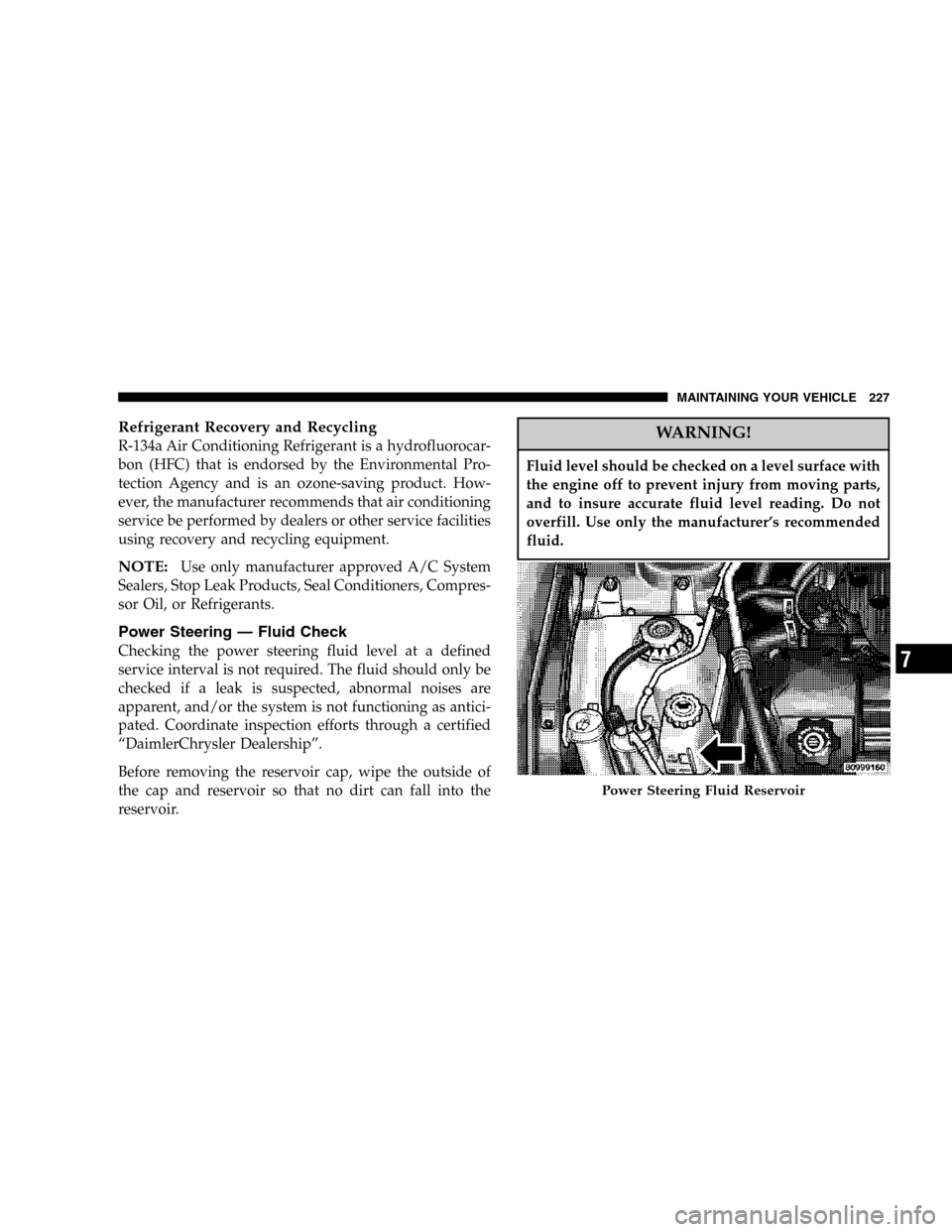2006 CHRYSLER SEBRING SEDAN checking oil
[x] Cancel search: checking oilPage 47 of 300

•To avoid drawing exhaust gases into the vehicle, close
the trunk while driving. However, if for some reason it
must remain open, close all windows. Adjust the
heating or cooling system to force outside air into the
vehicle. Set the blower at high speed.
Safety Checks You Should Make Inside the Vehicle
Seat Belts
Inspect the belt system periodically, checking for cuts,
frays and loose parts. Damaged parts must be replaced
immediately. Do not disassemble or modify the system.
Safety belt assemblies must be replaced after a collision if
they have been damaged (bent retractor, torn webbing,
etc.). If there is any question regarding belt or retractor
condition, replace the belt.
Airbag Light
The light should come on and remain on for 6 to
8 seconds as a bulb check when the ignition
switch is first turned ON. If the bulb is not lit
during starting, have it replaced. If the light stays on or
comes on while driving, have the system checked by an
authorized dealer.
Defrosters
Check operation by selecting the defrost mode and place
the blower control on high speed. You should be able to
feel the air directed against the windshield.
Periodic Safety Checks You Should Make Outside
the Vehicle
Tires
Examine tires for excessive tread wear or uneven wear
patterns. Check for stones, nails, glass, or other objects
lodged in the tread. Inspect for tread cuts or sidewall
cracks. Check wheel nuts for tightness, and tires (includ-
ing spare) for proper pressure.
Lights
Have someone observe the operation of exterior lights
while you work the controls. Check turn signal and high
beam indicator lights on the instrument panel.
Fluid Leaks
Check area under vehicle after overnight parking for fuel,
water, oil, or other fluid leaks. Also, if gasoline fumes are
present, the cause should be corrected immediately.
THINGS TO KNOW BEFORE STARTING YOUR VEHICLE 47
2
Page 218 of 300

WARNING!
You can be badly injured working on or around a
motor vehicle. Do only that service work for which
you have the knowledge and the proper equipment.
If you have any doubt about your ability to perform
a service job, take your vehicle to a competent
mechanic.
MAINTENANCE PROCEDURES
The pages that follow contain therequiredmaintenance
services determined by the engineers who designed your
vehicle.
Besides the maintenance items for which there are fixed
maintenance intervals, there are other items that should
operate satisfactorily without periodic maintenance.
However, if a malfunction of these items does occur, it
could adversely affect the engine or vehicle performance.
These items should be inspected if a malfunction is
observed or suspected.
Engine Oil
Checking Oil Level
To assure proper lubrication of your vehicle’s engine, the
engine oil must be maintained, at the correct level. Check
the oil level at regular intervals, such as every fuel stop.
The best time to check the oil level is about 5 minutes
after a fully warmed engine is shut off or before starting
the engine after it has sat overnight.
Checking the oil while the vehicle is on level ground will
improve the accuracy of the oil level readings. Maintain
the oil level between the MIN and MAX markings on the
dipstick. Adding one quart of oil when the reading is at
the MIN mark will result in a MAX reading on these
engines.
218 MAINTAINING YOUR VEHICLE
Page 227 of 300

Refrigerant Recovery and Recycling
R-134a Air Conditioning Refrigerant is a hydrofluorocar-
bon (HFC) that is endorsed by the Environmental Pro-
tection Agency and is an ozone-saving product. How-
ever, the manufacturer recommends that air conditioning
service be performed by dealers or other service facilities
using recovery and recycling equipment.
NOTE:Use only manufacturer approved A/C System
Sealers, Stop Leak Products, Seal Conditioners, Compres-
sor Oil, or Refrigerants.
Power Steering — Fluid Check
Checking the power steering fluid level at a defined
service interval is not required. The fluid should only be
checked if a leak is suspected, abnormal noises are
apparent, and/or the system is not functioning as antici-
pated. Coordinate inspection efforts through a certified
“DaimlerChrysler Dealership”.
Before removing the reservoir cap, wipe the outside of
the cap and reservoir so that no dirt can fall into the
reservoir.
WARNING!
Fluid level should be checked on a level surface with
the engine off to prevent injury from moving parts,
and to insure accurate fluid level reading. Do not
overfill. Use only the manufacturer’s recommended
fluid.
Power Steering Fluid Reservoir
MAINTAINING YOUR VEHICLE 227
7
Page 262 of 300

At Each Stop for Fuel
•
Check the engine oil level about 5 minutes after a fully
warmed engine is shut off. Checking the oil level while
the vehicle is on level ground will improve the accu-
racy of the oil level reading. Add oil only when the
level is at or below the ADD or MIN mark.
•Check the windshield washer solvent and add if
required.
Once a Month
•
Check tire pressure and look for unusual wear or
damage.
•Inspect the battery and clean and tighten the terminals
as required.
•Check the fluid levels of coolant reservoir, brake
master cylinder, and transaxle and add as needed.
•Check all lights and all other electrical items for correct
operation.
•Check rubber seals on each side of the radiator for
proper fit.
At Each Oil Change
•
Change the engine oil filter.
•Inspect the exhaust system.
•Inspect the brake linings, hoses and calipers.
•Inspect the CV joints and front and rear suspension
components.
•Check the automatic transmission fluid level.
•Check the brake master cylinder fluid level.
•Check the coolant level, hoses, and clamps.
NOTE:In 2.7L Engines equipped with Flex Fuel Engine
(FFV), change engine oil every 5 months or 5,000 miles,
whichever comes first. This applies to both Maintenance
Schedule A and B.
262 MAINTENANCE SCHEDULES
8
M
A
I
N
T
E
N
A
N
C
E
S
C
H
E
D
U
L
E
S
Page 289 of 300

Cruise Light........................... 88
Customer Assistance.................... 278
Daytime Brightness, Interior Lights.......... 63
Daytime Running Lights.................. 66
Dealer Service......................... 217
Defroster, Rear Window.................. 138
Defroster, Windshield...............47,132,138
Diagnostic System, Onboard............... 215
Dimmer Control........................ 63
Dimmer Switch, Headlight................. 66
Dipsticks
Automatic Transaxle................... 239
Disposal
Antifreeze (Engine Coolant)............. 234
Engine Oil.......................... 221
Door Ajar Warning...................... 15
Door Locks............................ 13
Door Locks, Automatic................... 15
Door Opener, Garage..................... 73
Drive Belts............................ 222
Driving
On Slippery Surfaces.................. 208E-85 Fuel............................. 181
Electrical Outlet, Auxiliary (Power Outlet)..... 80
Electrical Power Outlets................... 80
Electronic Speed Control (Cruise Control)...... 70
Emergency, In Case of
Freeing Vehicle When Stuck............. 209
Jacking............................. 200
Jump Starting........................ 205
Overheating......................... 198
Towing............................. 209
Emergency Trunk Release................. 23
Emission Control System Maintenance....216,260
Engine............................213,214
Air Cleaner Filter..................... 222
Block Heater......................... 148
Break-In Recommendations............... 46
Checking Oil Level.................... 218
Compartment.....................213,214
Coolant (Antifreeze)................232,256
Cooling............................ 231
Exhaust Gas Caution.................. 180
Fails to Start......................... 148
Fuel Requirements.................178,255
INDEX 289
10
Page 294 of 300

Locks
Central.............................. 15
Child Protection....................... 17
Cylinder............................ 228
Cylinder Maintenance.................. 228
Door............................... 13
Ignition.............................. 9
Lower Anchors and Tether for CHildren
(LATCH).............................. 42
Lubricants............................ 228
Lubrication, Body....................... 228
Luggage/Cargo Capacity................. 185
Lumbar Support........................ 58
Maintenance Free Battery................. 224
Maintenance Procedures.................. 218
Maintenance Schedule................... 260
Light Duty Schedule “B”................ 263
Schedule “A”........................ 272
Schedule “B”........................ 263
Malfunction Indicator Light
(Check Engine)......................89,216
Manual, Service........................ 281Mirrors............................... 54
Automatic Dimming.................... 54
Electric Remote....................... 55
Outside...........................55,56
Rearview............................ 54
Vanity.............................. 56
Modifications/Alterations, Vehicle............ 6
Mopar Parts........................217,280
Multi-Function Control Lever............... 64
Navigation System...................... 118
New Vehicle Break-In Period............... 46
Occupant Restraints...................... 25
Odometer............................. 91
Tampering........................... 91
Trip ................................ 91
Oil, Engine......................218,255,256
Capacity............................ 255
Change Interval...................... 219
Checking........................... 218
Disposal............................ 221
Filter...........................221,256
294 INDEX